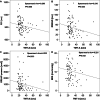Cardiovascular autonomic regulation correlates with cognitive performance in patients with a history of traumatic brain injury
- PMID: 37227563
- PMCID: PMC10495484
- DOI: 10.1007/s10072-023-06857-y
Cardiovascular autonomic regulation correlates with cognitive performance in patients with a history of traumatic brain injury
Abstract
Background and objective: Traumatic brain injury (TBI) may afflict brain areas contributing to both cardiovascular autonomic regulation and cognitive performance. To evaluate possible associations between both functions in patients with a history of TBI (post-TBI-patients), we determined correlations between cardiovascular autonomic regulation and cognitive function in post-TBI-patients.
Methods: In 86 post-TBI-patients (33.1 ± 10.8 years old, 22 women, 36.8 ± 28.9 months after injury), we monitored RR intervals (RRI), systolic and diastolic blood pressures (BPsys, BPdia), and respiration (RESP) at rest. We calculated parameters of total cardiovascular autonomic modulation (RRI-standard-deviation (RRI-SD), RRI-coefficient-of-variation (RRI-CV), RRI-total-powers), sympathetic (RRI-low-frequency-powers (RRI-LF), normalized (nu) RRI-LF-powers, BPsys-LF-powers) and parasympathetic modulation (root-mean-square-of-successive-RRI-differences (RMSSD), RRI-high-frequency-powers (RRI-HF), RRI-HFnu-powers), sympathetic-parasympathetic balance (RRI-LF/HF-ratios), and baroreflex sensitivity (BRS). We used the Mini-Mental State Examination and Clock Drawing Test (CDT) to screen the general global and visuospatial cognitive function, and applied the standardized Trail Making Test (TMT)-A assessing visuospatial abilities and TMT-B assessing executive function. We calculated correlations between autonomic and cognitive parameters (Spearman's rank correlation test; significance: P < 0.05).
Results: CDT values positively correlated with age (P = 0.013). TMT-A values inversely correlated with RRI-HF-powers (P = 0.033) and BRS (P = 0.043), TMT-B values positively correlated with RRI-LFnu-powers (P = 0.015), RRI-LF/HF-ratios (P = 0.036), and BPsys-LF-powers (P = 0.030), but negatively with RRI-HFnu-powers (P = 0.015).
Conclusions: In patients with a history of TBI, there is an association between decreased visuospatial and executive cognitive performance and reduced parasympathetic cardiac modulation and baroreflex sensitivity with relatively increased sympathetic activity. Altered autonomic control bears an increased cardiovascular risk; cognitive impairment compromises quality of life and living conditions. Thus, both functions should be monitored in post-TBI-patients.
Keywords: Cardiovascular autonomic regulation; Cognitive performance; Correlations; Executive function; Traumatic brain injury; Visuospatial function.
© 2023. The Author(s).
Conflict of interest statement
The authors declare no competing interests.
Figures


Similar articles
-
Severity of traumatic brain injury correlates with long-term cardiovascular autonomic dysfunction.J Neurol. 2017 Sep;264(9):1956-1967. doi: 10.1007/s00415-017-8581-1. Epub 2017 Aug 2. J Neurol. 2017. PMID: 28770375 Free PMC article.
-
Eyeball pressure stimulation induces subtle sympathetic activation in patients with a history of moderate or severe traumatic brain injury.Clin Neurophysiol. 2018 Jun;129(6):1161-1169. doi: 10.1016/j.clinph.2018.03.011. Epub 2018 Mar 30. Clin Neurophysiol. 2018. PMID: 29635100
-
Eyeball Pressure Stimulation Unveils Subtle Autonomic Cardiovascular Dysfunction in Persons with a History of Mild Traumatic Brain Injury.J Neurotrauma. 2015 Nov 15;32(22):1796-804. doi: 10.1089/neu.2014.3842. Epub 2015 Sep 23. J Neurotrauma. 2015. PMID: 26192266
-
Effects of weight changes in the autonomic nervous system: A systematic review and meta-analysis.Clin Nutr. 2019 Feb;38(1):110-126. doi: 10.1016/j.clnu.2018.01.006. Epub 2018 Jan 9. Clin Nutr. 2019. PMID: 29395374
-
Heart rate variability in hypothyroid patients: A systematic review and meta-analysis.PLoS One. 2022 Jun 3;17(6):e0269277. doi: 10.1371/journal.pone.0269277. eCollection 2022. PLoS One. 2022. PMID: 35657799 Free PMC article.
Cited by
-
Association between cardiac autonomic dysfunction, cognitive impairment, and survival in patients with amyotrophic lateral sclerosis.Clin Auton Res. 2025 Jun;35(3):465-476. doi: 10.1007/s10286-025-01112-0. Epub 2025 Mar 8. Clin Auton Res. 2025. PMID: 40056296 Free PMC article.
References
MeSH terms
LinkOut - more resources
Full Text Sources
Medical
Research Materials
Miscellaneous

